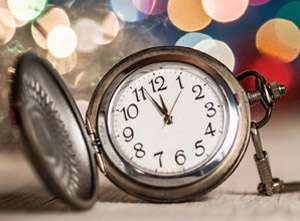What will you do with your extra second?

This New Year's countdown will be one second longer as the National Physical Laboratory (NPL) introduces the 27th leap second into UTC(NPL), the UK's timescale. The additional second will keep the timescale based on atomic clocks in sync with time based on the Earth's rotation.
Peter Whibberley, Senior Research Scientist in the Time & Frequency Group at NPL, said: "Atomic clocks are more than a million times better at keeping time than the rotation of the Earth, which fluctuates unpredictably. Leap seconds are needed to prevent civil time drifting away from Earth time. Although the drift is small – taking around a thousand years to accumulate a one-hour difference – if not corrected, it would eventually result in clocks showing midday before sunrise."
The International Earth Rotation and Reference Systems Service (IERS), based at the Paris Observatory, measures the Earth's rotation and announces when a leap second is needed roughly six months in advance. Leap seconds typically occur every two or three years and the last one was inserted in June 2015.
While leap seconds are needed to keep atomic time in sync with astronomical time, they can cause problems if not properly implemented.
Dr Leon Lobo, Strategic Business Development Manager for NPLTime, said: "Because leap seconds are only introduced sporadically, they have to be manually programmed into computers and getting them wrong can cause loss of synchronisation in communication networks, financial systems and many other applications which rely on precise timing."
NPL is the UK's national measurement institute and the birthplace of atomic time. NPL provides the UK's national time scale UTC(NPL), which is controlled using its caesium fountains NPL-CsF2 and CsF3 which are among the most accurate clocks in the world, and is responsible for inserting the leap second in the UK. Private organisations can link to NPL to add redundancy to their time-reliant systems through NPL's NPLTime service.
NPL is working on developing the next generation of atomic clocks, optical clocks based on laser-cooled trapped ions and atoms, which should achieve accuracies equivalent to one second over the lifetime of the universe. The most accurate atomic clocks still occupy entire labs. By making accurate atomic clocks portable, we could unlock the benefits of precise timing for countless applications. In the near future, we could use miniature atomic clocks to send unhackable communications, improve deep space navigation, and eventually integrate them into smartphones, increasing data transfer rates in communications networks. NPL already offers the NPLTime service for the financial industry to help timestamp high-frequency trades, and reduce the reliance on vulnerable GPS for timing.
Provided by National Physical Laboratory



















